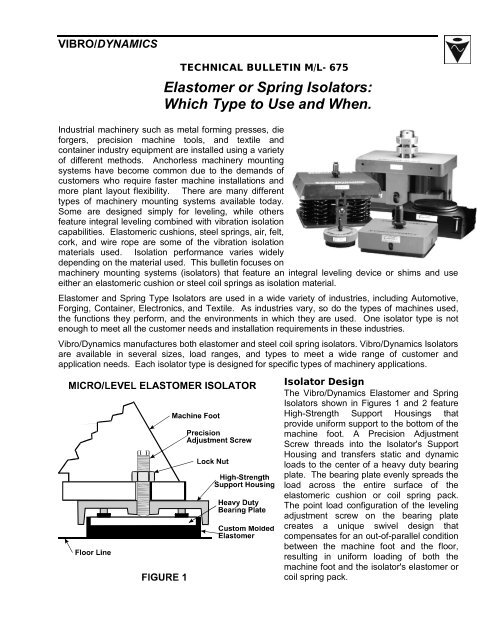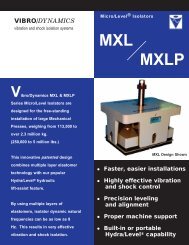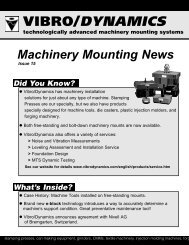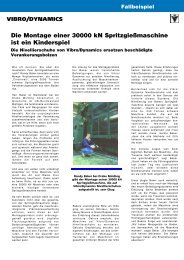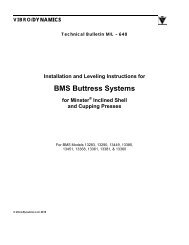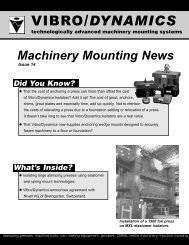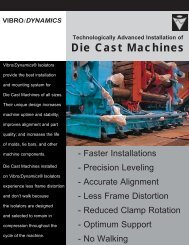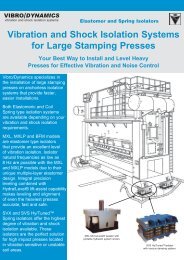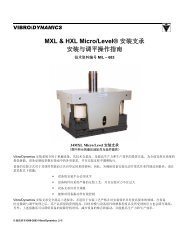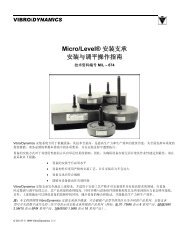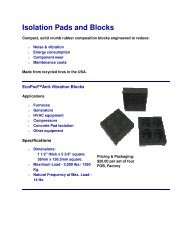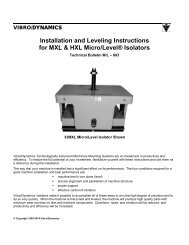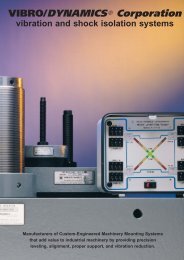Elastomer or Spring Isolators - Vibro/Dynamics Corporation
Elastomer or Spring Isolators - Vibro/Dynamics Corporation
Elastomer or Spring Isolators - Vibro/Dynamics Corporation
You also want an ePaper? Increase the reach of your titles
YUMPU automatically turns print PDFs into web optimized ePapers that Google loves.
VIBRO/DYNAMICS<br />
TECHNICAL BULLETIN M/L- 675<br />
<strong>Elastomer</strong> <strong>or</strong> <strong>Spring</strong> Isolat<strong>or</strong>s:<br />
Which Type to Use and When.<br />
Industrial machinery such as metal f<strong>or</strong>ming presses, die<br />
f<strong>or</strong>gers, precision machine tools, and textile and<br />
container industry equipment are installed using a variety<br />
of different methods. Anch<strong>or</strong>less machinery mounting<br />
systems have become common due to the demands of<br />
customers who require faster machine installations and<br />
m<strong>or</strong>e plant layout flexibility. There are many different<br />
types of machinery mounting systems available today.<br />
Some are designed simply f<strong>or</strong> leveling, while others<br />
feature integral leveling combined with vibration isolation<br />
capabilities. <strong>Elastomer</strong>ic cushions, steel springs, air, felt,<br />
c<strong>or</strong>k, and wire rope are some of the vibration isolation<br />
materials used. Isolation perf<strong>or</strong>mance varies widely<br />
depending on the material used. This bulletin focuses on<br />
machinery mounting systems (isolat<strong>or</strong>s) that feature an integral leveling device <strong>or</strong> shims and use<br />
either an elastomeric cushion <strong>or</strong> steel coil springs as isolation material.<br />
<strong>Elastomer</strong> and <strong>Spring</strong> Type Isolat<strong>or</strong>s are used in a wide variety of industries, including Automotive,<br />
F<strong>or</strong>ging, Container, Electronics, and Textile. As industries vary, so do the types of machines used,<br />
the functions they perf<strong>or</strong>m, and the environments in which they are used. One isolat<strong>or</strong> type is not<br />
enough to meet all the customer needs and installation requirements in these industries.<br />
<strong>Vibro</strong>/<strong>Dynamics</strong> manufactures both elastomer and steel coil spring isolat<strong>or</strong>s. <strong>Vibro</strong>/<strong>Dynamics</strong> Isolat<strong>or</strong>s<br />
are available in several sizes, load ranges, and types to meet a wide range of customer and<br />
application needs. Each isolat<strong>or</strong> type is designed f<strong>or</strong> specific types of machinery applications.<br />
Isolat<strong>or</strong> Design<br />
The <strong>Vibro</strong>/<strong>Dynamics</strong> <strong>Elastomer</strong> and <strong>Spring</strong><br />
Isolat<strong>or</strong>s shown in Figures 1 and 2 feature<br />
High-Strength Supp<strong>or</strong>t Housings that<br />
provide unif<strong>or</strong>m supp<strong>or</strong>t to the bottom of the<br />
machine foot. A Precision Adjustment<br />
Screw threads into the Isolat<strong>or</strong>'s Supp<strong>or</strong>t<br />
Housing and transfers static and dynamic<br />
loads to the center of a heavy duty bearing<br />
plate. The bearing plate evenly spreads the<br />
load across the entire surface of the<br />
elastomeric cushion <strong>or</strong> coil spring pack.<br />
The point load configuration of the leveling<br />
adjustment screw on the bearing plate<br />
creates a unique swivel design that<br />
compensates f<strong>or</strong> an out-of-parallel condition<br />
between the machine foot and the flo<strong>or</strong>,<br />
resulting in unif<strong>or</strong>m loading of both the<br />
machine foot and the isolat<strong>or</strong>'s elastomer <strong>or</strong><br />
coil spring pack.
The <strong>Vibro</strong>/<strong>Dynamics</strong> Hy/Tuned <strong>Spring</strong><br />
Isolat<strong>or</strong>, shown in Figure 3, uses shims f<strong>or</strong><br />
leveling. Shims are usually installed between<br />
the foot and the isolat<strong>or</strong> and secured using<br />
either a hold-down bolt <strong>or</strong> a friction pad.<br />
Technical Bulletin M/L – 675<br />
Isolat<strong>or</strong> Application<br />
The application of vibration isolat<strong>or</strong>s and their<br />
natural frequencies relative to machine<br />
operating speeds falls into two broad<br />
categ<strong>or</strong>ies: low-tuned and high-tuned. A lowtuned<br />
application is when the natural frequency<br />
of the vibration isolat<strong>or</strong> is less than the<br />
operating frequency of the machine, thus<br />
isolating the inertial f<strong>or</strong>ces generated at the<br />
machine’s operating speed. A high-tuned<br />
application is when the natural frequency of the<br />
vibration isolat<strong>or</strong> is greater than the operating<br />
frequency of the machine. The inertial f<strong>or</strong>ce<br />
generated at the machine’s operating speed is<br />
not isolated, but high-frequency vibration<br />
caused by impact f<strong>or</strong>ces is effectively isolated.<br />
<strong>Elastomer</strong>ic isolat<strong>or</strong>s are generally used f<strong>or</strong> high-tuned machinery applications. Coil <strong>Spring</strong> Isolat<strong>or</strong>s<br />
can be used f<strong>or</strong> both low-tuned and high-tuned machinery applications.<br />
Machines that generate high inertial f<strong>or</strong>ces relative to machine weight usually have to be installed in a<br />
high-tuned condition to control excessive machine motion. <strong>Elastomer</strong> isolat<strong>or</strong>s are ideal f<strong>or</strong> this type<br />
of application because they are generally stiffer than spring isolat<strong>or</strong>s and better control motion<br />
caused by out-of-balance f<strong>or</strong>ces. Most machines<br />
are not dynamically balanced and generate<br />
impact, rocking, and inertial f<strong>or</strong>ces, causing them<br />
to move excessively if mounted on an isolat<strong>or</strong> that<br />
is too soft.<br />
Micro/Level <strong>Elastomer</strong> and Hy/Tuned SVS<br />
<strong>Spring</strong> Isolat<strong>or</strong>s are very effective in reducing<br />
vibration caused by impact f<strong>or</strong>ces (up to 98%<br />
documented). Micro/Level elastomer isolat<strong>or</strong>s are<br />
an excellent choice when installing presses in an<br />
industrial area. Hy/Tuned SVS model spring<br />
mounts should be selected if a higher degree of<br />
isolation is required to head off potential neighb<strong>or</strong><br />
problems <strong>or</strong> if sensitive machinery is close by.<br />
Micro/Level <strong>Elastomer</strong> and SVS Hy/Tuned<br />
<strong>Spring</strong> Isolat<strong>or</strong>s are typically applied with vertical<br />
natural frequencies greater than the machine's<br />
operating speed range (high-tuned application).<br />
2443 Braga Drive · Broadview, Illinois 60155-3941 USA · 708-345-2050 · Toll Free 1-800-842-7668 · Fax: 708-345-2225<br />
www.vibrodynamics.com · vibro@vibrodynamics.com<br />
ML-675 20150102 Page 2 of 5
Technical Bulletin M/L – 675<br />
The Transmitted Inertial F<strong>or</strong>ce Curves shows the machine speed ranges f<strong>or</strong> High-Tuned <strong>Elastomer</strong><br />
and <strong>Spring</strong> Isolat<strong>or</strong>s and Low-Tuned <strong>Spring</strong> Isolat<strong>or</strong>s. High-Tuned Isolat<strong>or</strong>s have machine speed<br />
ranges that are less than the isolat<strong>or</strong>’s vertical natural frequency (300 SPM <strong>or</strong> 5 Hz f<strong>or</strong> the High-Tuned<br />
<strong>Spring</strong> Isolat<strong>or</strong> and 900 SPM <strong>or</strong> 15 Hz f<strong>or</strong> the High-Tuned <strong>Elastomer</strong> Isolat<strong>or</strong>s). Impact f<strong>or</strong>ces are effectively<br />
isolated but, since the isolat<strong>or</strong>'s vertical natural frequency is greater than the machine's speed range,<br />
the inertial f<strong>or</strong>ces are not isolated. Inertial f<strong>or</strong>ces are low at low speeds, but build exponentially as the<br />
machine speed increases. Transmitted inertial f<strong>or</strong>ce increases as the machine speed nears the<br />
isolat<strong>or</strong>’s natural frequency.<br />
Low-Tuned Coil spring isolat<strong>or</strong>s, like <strong>Vibro</strong>/<strong>Dynamics</strong> Hy/Speed VS <strong>Spring</strong> Isolat<strong>or</strong>s, are very<br />
effective in reducing both Impact and Inertial f<strong>or</strong>ces. These isolat<strong>or</strong>s should be used selected when<br />
sensitive machinery <strong>or</strong> neighb<strong>or</strong>s are located nearby. These isolat<strong>or</strong>s have a vertical natural<br />
frequency that is less than the machine's operating speed range (Low-Tuned application). Transmitted<br />
inertial f<strong>or</strong>ces are reduced when the machine's speed range (Low-Tuned <strong>Spring</strong> Range) is at least 1.41<br />
times greater than the isolat<strong>or</strong>'s vertical natural frequency. F<strong>or</strong> example, the Low-Tuned Isolat<strong>or</strong><br />
shown in the Transmitted Inertial F<strong>or</strong>ce Curves has a vertical natural frequency of 2.5 Hz <strong>or</strong> 150<br />
SPM. This isolat<strong>or</strong> will begin to isolate inertial f<strong>or</strong>ces at approximately 3.5 Hz <strong>or</strong> 212 SPM.<br />
Low-Tuned spring isolat<strong>or</strong>s typically are recommended f<strong>or</strong> well-balanced presses with speeds greater<br />
than 250. When applied in the Low-Tuned <strong>Spring</strong> Range, Hy/Speed (Low-Tuned) Isolat<strong>or</strong>s are very<br />
effective in reducing transmitted impact and inertial f<strong>or</strong>ces, but due to their low natural frequency and<br />
softness, excessive motion may result if large out-of-balance f<strong>or</strong>ces exist. This type of isolat<strong>or</strong> can<br />
also be used at speeds less than the isolat<strong>or</strong>'s natural frequency (e.g., 1-100 SPM), but it then<br />
becomes a high-tuned application and the inertial f<strong>or</strong>ces will not be isolated since the isolat<strong>or</strong>'s<br />
vertical natural frequency now is greater than the speed range.<br />
2443 Braga Drive · Broadview, Illinois 60155-3941 USA · 708-345-2050 · Toll Free 1-800-842-7668 · Fax: 708-345-2225<br />
www.vibrodynamics.com · vibro@vibrodynamics.com<br />
ML-675 20150102 Page 3 of 5
Types of Motion<br />
Technical Bulletin M/L – 675<br />
There are two main types of motion that can occur: transient and steady-state. Transient motion<br />
occurs when the machine starts, stops, <strong>or</strong> when it runs through the isolat<strong>or</strong>'s natural frequency<br />
(resonance). As the machine's speed passes through resonance, the unbalanced f<strong>or</strong>ces generated<br />
by the machine are amplified and may cause excessive motion. One of the ways this motion can be<br />
controlled is by simply accelerating quickly through resonance bef<strong>or</strong>e the f<strong>or</strong>ces and motion have a<br />
chance to build, usually within a few strokes <strong>or</strong> revolutions of the machine. Steady-State motion<br />
occurs when the machine is running at its n<strong>or</strong>mal operating speed. Motion is caused by the out-ofbalance<br />
f<strong>or</strong>ces generated by the machine and may be excessive if the vertical inertial f<strong>or</strong>ce exceeds<br />
10 percent of the machine's static weight.<br />
Damping Systems<br />
Proper damping of any low natural frequency isolat<strong>or</strong> is essential f<strong>or</strong> controlling transient and<br />
steady state machine motion. Damping is very effective f<strong>or</strong> controlling transient motion. The type of<br />
damping used depends on the application. Too much damping can increase the amount of<br />
transmitted f<strong>or</strong>ce, and too little can result in excess motion. Hy/Speed and Hy/Tuned <strong>Spring</strong> Isolat<strong>or</strong>s<br />
are available with either Material <strong>or</strong> Viscous Damping. Material Damping typically is used when a<br />
machine's operating speed is well above resonance and resonance is passed through quickly.<br />
Viscous Damping is recommended f<strong>or</strong> machines that operate close to resonance, have high out-ofbalance<br />
f<strong>or</strong>ces, <strong>or</strong> pass through resonance slowly. Material Damped Isolat<strong>or</strong>s are usually smaller<br />
and less costly than Viscous Damped Isolat<strong>or</strong>s.<br />
The following Chart shows the relative motion comparison between Viscous and Material Damping,<br />
and illustrates how Viscous Damping is m<strong>or</strong>e effective in controlling machine motion at <strong>or</strong> near<br />
resonance. As machine speed increases and gets farther away from resonance, the difference in<br />
machine motion and damping effectiveness between Viscous and Material Damping lessens.<br />
2443 Braga Drive · Broadview, Illinois 60155-3941 USA · 708-345-2050 · Toll Free 1-800-842-7668 · Fax: 708-345-2225<br />
www.vibrodynamics.com · vibro@vibrodynamics.com<br />
ML-675 20150102 Page 4 of 5
Summary<br />
Technical Bulletin M/L – 675<br />
Proper machine supp<strong>or</strong>t, leveling, alignment, and vibration reduction are critical f<strong>or</strong> any successful<br />
machine installation. A properly supp<strong>or</strong>ted machine will move less, perf<strong>or</strong>m better, and last longer.<br />
<strong>Vibro</strong>/<strong>Dynamics</strong>' Micro/Level® and Hy/Speed Isolat<strong>or</strong>s are available with built-in precision<br />
adjustment capabilities that make leveling, alignment, and supp<strong>or</strong>t adjustments fast and easy.<br />
<strong>Vibro</strong>/<strong>Dynamics</strong>' Hy/Tuned Isolat<strong>or</strong>s are great f<strong>or</strong> solving difficult vibration and shock transmission<br />
problems resulting from heavy blanking <strong>or</strong> f<strong>or</strong>ging operations.<br />
Decisions on Which Type of Isolat<strong>or</strong>s to Use and When should be made after consulting experts who<br />
have the experience, the product line, and the application knowledge required to select the best<br />
machinery installation method. A th<strong>or</strong>ough application analysis should be done in <strong>or</strong>der to determine<br />
which isolat<strong>or</strong> type is best f<strong>or</strong> a particular application. A machine's operating characteristics, design,<br />
structure, weight, and dynamic f<strong>or</strong>ces should be analyzed to determine which isolat<strong>or</strong> type could <strong>or</strong><br />
should be used. In some cases, either type may be used, and the final isolat<strong>or</strong> type will be<br />
determined by the degree of vibration isolation desired and the amount of machine motion that is<br />
acceptable.<br />
<strong>Vibro</strong>/<strong>Dynamics</strong>®, Micro/Level®, and Hydra/Level® are registered trademarks and Hy/Tuned, Lo/Tuned, and Hy/Speed,<br />
are trademarks of the <strong>Vibro</strong>/<strong>Dynamics</strong> LLC. © Copyright 2000-2015 <strong>Vibro</strong>/<strong>Dynamics</strong> LLC. All rights reserved.<br />
2443 Braga Drive · Broadview, Illinois 60155-3941 USA · 708-345-2050 · Toll Free 1-800-842-7668 · Fax: 708-345-2225<br />
www.vibrodynamics.com · vibro@vibrodynamics.com<br />
ML-675 20150102 Page 5 of 5


